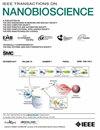Stability Analysis for Large-Scale Multi-Agent Molecular Communication Systems
IF 4.4
4区 生物学
Q1 BIOCHEMICAL RESEARCH METHODS
引用次数: 0
Abstract
Molecular communication (MC) is recently featured as a novel communication tool to connect individual biological nanorobots. It is expected that a large number of nanorobots can form large multi-agent MC systems through MC to accomplish complex and large-scale tasks that cannot be achieved by a single nanorobot. However, most previous models for MC systems assume a unidirectional diffusion communication channel and cannot capture the feedback between each nanorobot, which is important for multi-agent MC systems. In this paper, we introduce a system theoretic model for large-scale multi-agent MC systems using transfer functions, and then propose a method to analyze the stability for multi-agent MC systems. The proposed method decomposes the multi-agent MC system into multiple single-input and single-output (SISO) systems, which facilitates the application of simple analysis technique for SISO systems to the large-scale multi-agent MC system. Finally, we demonstrate the proposed method by analyzing the stability of a specific large-scale multi-agent MC system and clarify a parameter region to synchronize the states of nanorobots, which is important to make cooperative behaviors at a population level.大规模多代理分子通信系统的稳定性分析。
分子通讯(MC)作为一种新型的通讯工具,最近被广泛应用于连接单个生物纳米机器人。大量纳米机器人有望通过 MC 组成大型多代理 MC 系统,完成单个纳米机器人无法完成的复杂和大规模任务。然而,以往的 MC 系统模型大多假设单向扩散通信信道,无法捕捉每个纳米机器人之间的反馈,而这对于多代理 MC 系统非常重要。本文利用传递函数引入了大规模多代理 MC 系统的系统理论模型,然后提出了一种分析多代理 MC 系统稳定性的方法。所提出的方法将多代理 MC 系统分解为多个单输入和单输出(SISO)系统,从而便于将 SISO 系统的简单分析技术应用于大规模多代理 MC 系统。最后,我们通过分析特定大规模多代理 MC 系统的稳定性演示了所提出的方法,并阐明了使纳米机器人状态同步的参数区域,这对于在群体水平上实现合作行为非常重要。
本文章由计算机程序翻译,如有差异,请以英文原文为准。
求助全文
约1分钟内获得全文
求助全文
来源期刊

IEEE Transactions on NanoBioscience
工程技术-纳米科技
CiteScore
7.00
自引率
5.10%
发文量
197
审稿时长
>12 weeks
期刊介绍:
The IEEE Transactions on NanoBioscience reports on original, innovative and interdisciplinary work on all aspects of molecular systems, cellular systems, and tissues (including molecular electronics). Topics covered in the journal focus on a broad spectrum of aspects, both on foundations and on applications. Specifically, methods and techniques, experimental aspects, design and implementation, instrumentation and laboratory equipment, clinical aspects, hardware and software data acquisition and analysis and computer based modelling are covered (based on traditional or high performance computing - parallel computers or computer networks).
 求助内容:
求助内容: 应助结果提醒方式:
应助结果提醒方式:


